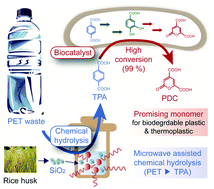A chemo-microbial hybrid process for the production of 2-pyrone-4,6-dicarboxylic acid as a promising bioplastic monomer from PET waste†
Abstract
In this study, 2-pyrone-4,6-dicarboxylic acid (PDC), a valuable monomer for bio-degradable plastics, was synthesised using terephthalic acid (TPA) derived from PET waste by a comprehensive chemo-microbial hybrid process. Depolymerisation of PET into TPA was performed via microwave-assisted hydrolysis using biomass-derived SiO2 catalysts with thiol functionalisation. The increased PET hydrolysis efficiency was investigated by reaction kinetics studies. The conversion of TPA obtained by depolymerisation of PET waste into PDC was achieved using two recombinant Escherichia coli strains expressing tphAabc and tphB genes for TPA degradation into protocatechuic acid (PCA) through 3,4-dihydroxy-cyclohexa-1,5-diene-1,4-dicarboxylic acid (DCD) (E. coli PCA strain) and using ligABC genes to convert PCA to PDC through 4-carboxy-2-hydroxymuconate semialdehyde (CHMS) (E. coli PDCPCA strain). Based on the high chemical depolymerisation of PET waste into TPA (over 97% efficiency), the double-catalyst system composed of the E. coli PCA strains with TPA degradation module and PDC synthesis module enables PET waste to be used in the PDC production platform with 96.08% of the overall efficiency.



 Please wait while we load your content...
Please wait while we load your content...